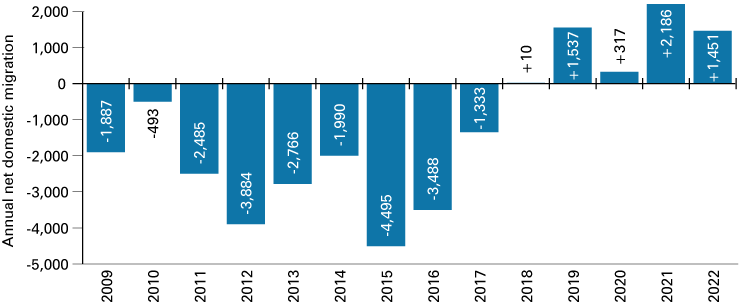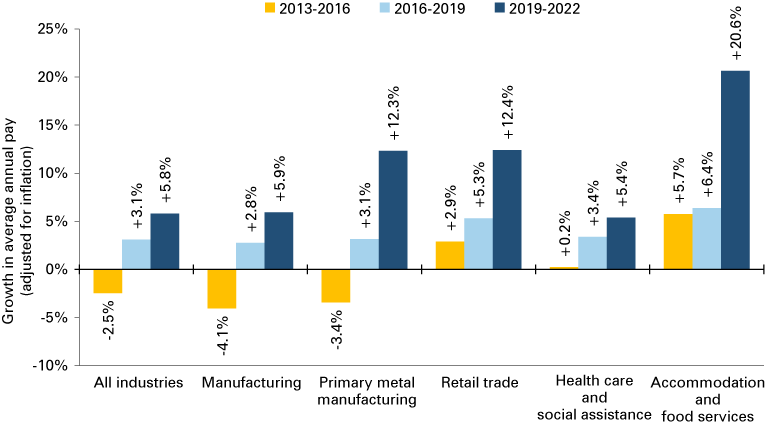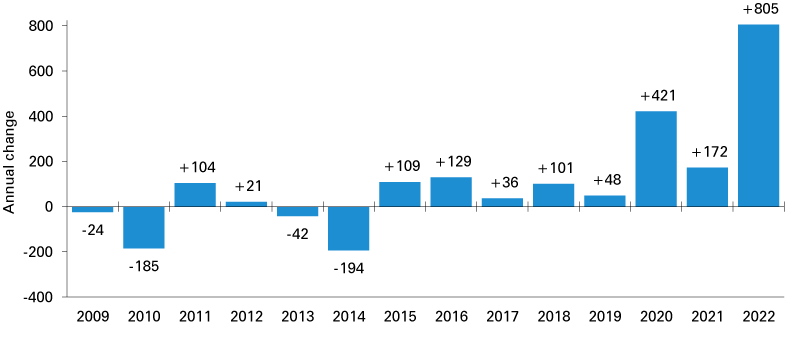Gary forecast 2024

Associate Professor of Economics and Director, Center for Economic Education & Research, School of Business and Economics, Indiana University Northwest
In an editorial published in The Times of Northwest Indiana on March 15th, 2020,1 I argued we needed to focus on quality of place and quality of life to ensure a prosperous economic future for the region. In short, that we needed to make Northwest Indiana “a place to live, not to leave.”
The first SARS-CoV-2 death in Indiana was reported the day the editorial was published and consideration of long-term plans for economic prosperity for the region became a secondary concern to the growing pandemic.
Despite this, I believe Northwest Indiana was at a figurative crossroads in early 2020 and since then, perhaps ironically with some assistance from the structural shifts in our economy caused by the pandemic, we have chosen to travel down the path that leads to greater economic prosperity.
A place to live, not to leave
The most convincing sign of growing prosperity in a region is when people choose to live there. More people moving into a region (or choosing to continue living there) than people moving away, also known as positive net domestic migration, demonstrates that a region is a desirable place to live and has a promising future. In recent decades, Northwest Indiana has struggled when measured by this metric. For the decade following the Great Recession of 2008, the region experienced negative net domestic migration as more people moved away from rather than into the region. Figure 1 shows annual net domestic migration for Northwest Indiana between 2009 and 2022. This effect was so substantial that it offset natural population growth and caused the population in Northwest Indiana to decline every year. Between 2010 and 2017, the population in Northwest Indiana declined by 1.0% (or -0.15% per year) while nationally, the population grew by 5.1% (+0.7% per year).2
Figure 1: Annual net domestic migration for Northwest Indiana

Source: U.S. Census Bureau, American Community Survey, county-to-county migration flows (https://www.census.gov/topics/population/migration/guidance/county-to-county-migration-flows.html)
However, since 2018, this trend has reversed. Today, more people are being attracted to and choosing to remain in Northwest Indiana than the number of those who leave. As a result, between 2017 and 2022, the population in Northwest Indiana has grown 2.9% (or 0.58% per year) and this growth is forecasted to continue in the coming years.3 The reversal of this out-migration trend can be attributed primarily to two factors. First, Northwest Indiana has become a stronger economic environment for both workers and firms. Second, Northwest Indiana has made significant investments in quality of place, which are starting to pay dividends in attracting and retaining workers and their families to the region.
A strong economic environment
Historically, the economy of Northwest Indiana has been primarily driven by manufacturing and other goods-producing industries. However, employment in these industries has been falling consistently since the 1970s. Today, manufacturing plays a smaller, but still very significant, role in the Northwest Indiana economy. For example, primary metal manufacturing generates 15% of all wages in Northwest Indiana, but employs just 6.3% of workers, down from 9.6% in the year 2002. In recent decades, there has been a significant rise in employment in the service-providing sector, particularly the industries of health care and social assistance, which has added 9,399 jobs since the year 2002 (+26%), and accommodation and food services, which has added 7,922 jobs since 2002 (+35%). In addition, retail trade continues to be a significant source of employment for the region. Table 1 shows employment, employment share and average annual pay for these industries in Northwest Indiana during 2022.
Table 1: Employment, employment share and pay for key industries in Northwest Indiana, 2022
| Employment | Share | Average annual pay | |
|---|---|---|---|
| Total, all industries | 252,837 | 100% | $55,874 |
| Health care and social assistance (NAICS 62) | 45,045 | 18% | $58,995 |
| Manufacturing (NAICS 31-33) | 39,929 | 16% | $91,087 |
| Primary metal manufacturing (NAICS 331) | 15,950 | 6% | $114,926 |
| Retail trade (NAICS 44-45) | 35,226 | 14% | $34,505 |
| Accommodation and food services (NAICS 72) | 31,146 | 12% | $21,807 |
Note: Due to data availability limitations, these data reflect the three counties of Lake, Porter and LaPorte.
Source: U.S. Bureau of Labor Statistics, Quarterly Census of Employment and Wages (QCEW)
The four key industries of health care and social assistance, manufacturing, retail trade and accommodation and food services together provide over 60% of all jobs and pay in Northwest Indiana. Since 2019, because of the economic forces and structural changes during the SARS-CoV-2 pandemic, these industries have seen the largest percentage growth in pay among all industries. Figure 2 shows the growth in average annual pay adjusted for inflation for these key industries over three 3-year periods. Since 2019, average annual pay, after being adjusted for inflation, has grown 5.8% on average across all industries in Northwest Indiana and the service-providing industries of retail trade and accommodation and food services have seen the largest growth in pay of any industry (+12.4% and +20.6%, respectively).
Figure 2: Growth in average annual real pay for key industries in Northwest Indiana

Note: Due to data limitations, these data reflect the three counties of Lake, Porter and LaPorte.
Source: U.S. Bureau of Labor Statistics, Quarterly Census of Employment and Wages (QCEW) and Consumer Price Index (CPI)
Rising pay among traditionally lower-paying industries, particularly when the increase is this dramatic, is an extremely effective way to improve income equality, reduce poverty and stimulate the local economy through higher spending multipliers. In addition, the unemployment rate in Northwest Indiana continues to be at a historical low of around 5%, indicating a very tight labor market and significant market power in the hands of workers.
During this time, the economic environment in Northwest Indiana has improved not only for workers, but also for firms. The widespread expansion of remote work during the pandemic meant that the geographic location of a business became less important. Northwest Indiana, with its combination of proximity to Chicago and many business-friendly features such as lower tax rates, lower property costs and excellent logistics, became a more attractive location for businesses. Figure 3 shows the annual change in the number of business establishments in Northwest Indiana since 2009.
During the decade between 2009 and 2019, the number of total business establishments rose by 103, with Northwest Indiana adding on average a net of just 10 new businesses per year. In contrast, over the last three years, Northwest Indiana has added a net of 1,398 new businesses, an increase of 9.2% or an average of 466 new businesses per year. For comparison, over the same time, Cook County, Illinois saw an increase of only 0.6%. The structural changes caused by the pandemic resulted in opportunities for new businesses and the economic environment of Northwest Indiana brought many of these new businesses to the region.
Figure 3: Annual change in the total number of business establishments in Northwest Indiana

Note: Due to data availability limitations, these data reflect the three counties of Lake, Porter and LaPorte.
Source: U.S. Bureau of Labor Statistics, Quarterly Census of Employment and Wages (QCEW)
While the global pandemic suppressed economic growth during 2019 and 2020 in Northwest Indiana, the region has surged back. In 2021, real GDP for Northwest Indiana grew by 1.7% and in 2022, it grew by 6.2%.4 Thus far in 2023, we are on track to achieve similar growth. The economic changes over the last few years have strengthened the economic environment in Northwest Indiana for both workers and firms and these changes will encourage and support greater economic growth for Northwest Indiana in the future.
Growing quality of place
While rising pay is a tangible factor for making Northwest Indiana a more attractive place for workers to live, a less tangible but equally important factor is quality of place. Higher wages will help attract workers and their families to Northwest Indiana. For them to stay, the region needs to offer high quality of place, with more convenient access to transportation and more and higher quality amenities of the type which matter to younger generations. While investments in quality of place take years or even decades to plan, implement and mature, Northwest Indiana began the process of investing in quality of place years ago and we are now beginning to see some of the significant benefits from this investment.
One example is improved and expanded mass transportation. The Indiana South Shore Line recently reached a major milestone in its expansion and began running the trains on the newly completed second track between Gary and Michigan City, significantly reducing commute times to Chicago.5 Access to transportation will continue to improve as efforts now shift to the West Lake Corridor extension traveling south in Lake County. There are many businesses in the greater Chicago metropolitan area offering flexibility in remote or partially remote work and improved transportation will make Northwest Indiana a more attractive place to live, particularly for workers who want convenient access to Chicago either for work or recreation.
In addition, the Ignite the Region economic initiative6 celebrated its five-year anniversary of coordinating and supporting economic development in the region. Through the Indiana READI 1 grant, the initiative has brought more than $700 million worth of total investment to Northwest Indiana, much of which focused on improvements to quality of place. These included expanding and improving green spaces and trails and the development of multi-use and walkable communities. These improvements dovetail with the extensive efforts of the Northwestern Indiana Regional Planning Commission (NIRPC) in creating livable communities and economic development districts. In addition to these examples, there are many efforts happening through local economic development organizations in the region focused on improving the quality of life and quality of place in Northwest Indiana. Together, these organizations have embraced the approach of using improved quality of place as a foundation, along with more traditional approaches to attract businesses, to build a stronger Northwest Indiana economy.
Finally, the strongest evidence for the success of improving quality of place in Northwest Indiana can be found in the housing market. Over the previous five years (2018-2022), there were 23% more building permits issued in Northwest Indiana than the five years before and the valuation for the typical building permit was 20% higher. Despite this rapid construction of residential housing and recent rising interest rates, the housing market in Northwest Indiana continues to remain very competitive.
Challenges and the forecast for 2024
The economic forecast for Northwest Indiana in the coming years is the most optimistic we have seen in decades. However, this does not mean we do not face challenges, many of which are related to human capital and the labor force. While Northwest Indiana has succeeded in achieving positive domestic migration overall, this is not the case within every age range. We continue to experience significant “brain drain” with more college-aged residents of Northwest Indiana moving out than moving into the region. Between 2010 and 2020, 13 out of every 100 people aged 20-29 moved away from Northwest Indiana. In contrast, the urban counties of Cook County, Illinois and Marion County, Indiana during this same period were net attractors of young talent and gained a net of 11 and 28 people aged 20-29 for every 100 existing residents in those counties, respectively.7 To make Northwest Indiana a place where businesses of the future want to locate, we need to continue taking steps to keep and attract more young, educated and skilled workers in Northwest Indiana. Continued improvements in quality of place will likely be the most effective way to do this.
A related challenge is the extremely tight labor market. Rising pay and difficulty finding workers pose significant challenges for many firms in Northwest Indiana. While the labor force participation rate in the region has yet to return fully to pre-pandemic levels, we will need more than these workers returning to the labor market to fill vacancies. As with the “brain drain” challenge, attracting more workers, and particularly young, educated and skilled workers, to Northwest Indiana will help alleviate pressure on the tight labor market and give firms a stronger pool of workers. For 2024, we can expect labor market conditions to remain tight with historically low unemployment rates.
In addition to regional migration and labor market challenges, national issues, such as rising interest rates, have increased the cost of borrowing. However, while a federal funds rate between 5% and 6% is very high in contrast to rates since the 2008/2009 housing market crisis, it is still well below the historical long-run average. As concerns about inflation continue to ease, interest rates will likely stabilize in 2024. With a stable interest rate, returns will adjust accordingly, which will reduce much of this pressure. Besides these economic challenges, we will likely continue to see significant national and international political instability over the next few years.
In the coming year, Northwest Indiana is poised for some of its strongest economic growth in over a decade. Table 2 provides a forecast of key economic variables for Northwest Indiana in 2024. While we will always face economic challenges, some of which we can prepare for and others we cannot, Northwest Indiana is in an excellent position to confront these challenges. When faced with a crossroads, Northwest Indiana has chosen to follow a path for strong economic growth which will lead us to a more prosperous future.
Table 2: Northwest Indiana regional forecast for 2024
| 2024 Forecast | ||
|---|---|---|
| Real GDP | Moderate growth | +1-2% (+$300 to $600 million) |
| Labor market (Q2 to Q2) | ||
| Employment | Slight growth | +0.5% (+850 jobs) |
| Labor force | Slight growth | +0.25% (+850 people) |
| Unemployment rate | Unchanged | Between 4.5% and 5.5% |
| Income | ||
| Total wages and salaries | Strong growth | +2-3% (+$300-$500 million) |
| Personal income | Strong growth | +3-4% (+$1.3-$1.7 billion) |
Source: “Indiana MSA Forecast,” Indiana University Center for Econometric Model Research and author’s calculations
Notes
- Pollak, M. “Guest commentary: The region is at an economic crossroads,” The Times of Northwest Indiana, March 15, 2020, https://www.nwitimes.com/news/opinion/columnists/guest-commentary/guest-commentary-the-region-is-at-an-economic-crossroads/article_317c363a-346a-5df4-9b03-716ebf84dbf7.html
- U.S. Census Bureau, American Community Survey (ACS)
- “Indiana MSA Forecast,” Indiana University Center for Econometric Model Research
- Ibid.
- Lanich, C. “South Shore Line testing first segments of new track in northwest Indiana,” Inside INdiana Business, September 6, 2023, https://www.insideindianabusiness.com/articles/south-shore-line-testing-first-segments-of-new-track-in-northwest-indiana
- More information on Ignite the Region at https://www.nwiforum.org/economic-initiative
- Net migration patterns for U.S. counties, Applied Population Lab, University of Wisconsin



